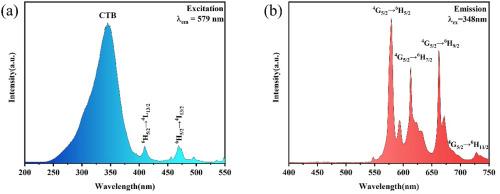固态照明用基质敏化NaBa10Y5W4O30: Sm3+橘红色荧光粉的能量传递工程
IF 3.5
3区 化学
Q2 CHEMISTRY, INORGANIC & NUCLEAR
引用次数: 0
摘要
采用高温固相反应法制备了一系列基质敏化的NaBa10Y5W4O30: xSm3+ (x = 0.01 ~ 0.09)橘红色荧光粉。通过XRD, SEM,光致发光光谱,荧光寿命测量,温度相关PL测量和CIE色度坐标分析系统地表征了它们的结构和发光性能。XRD分析证实了相纯化合物的成功合成,Sm3+离子的成功掺入没有造成明显的晶格畸变。SEM图像结合EDS图谱验证了样品中所有组成元素的均匀分布。在348 nm紫外光激发下,NaBa10Y5W4O30: Sm3+荧光粉在579 nm处表现出特征发射峰,对应于Sm3+的4G5/2→6H5/2跃迁。发射强度在x = 0.05处达到峰值,在此之后,Sm3+离子之间通过电偶极-偶极相互作用发生浓度猝灭。随着Sm3+离子浓度的增加,荧光寿命逐渐减少。此外,CIE色度坐标在橙红光区域保持稳定,298-423 K范围内的变温光谱表现出优异的热稳定性。通过CIE色度坐标(0.3514,0.3800)确认了封装的暖白光LED器件的暖白光发射特性。这些结果表明,NaBa10Y5W4O30: Sm3+橘红色荧光粉在白光LED照明中具有相当大的应用前景。本文章由计算机程序翻译,如有差异,请以英文原文为准。

Energy transfer engineering in matrix-sensitized NaBa10Y5W4O30: Sm3+ orange-red phosphors for solid-state lighting
A sequence of matrix-sensitized NaBa10Y5W4O30: xSm3+ (x = 0.01–0.09) orange-red phosphors was successfully fabricated using a high-temperature solid-state reaction method. Their structural and luminescence properties were systematically characterized by XRD, SEM, photoluminescence spectroscopy, fluorescence lifetime measurements, temperature-dependent PL measurements, and CIE chromaticity coordinate analysis. XRD analysis verified the successful synthesis of phase-pure compounds, with the successful incorporation of Sm3+ ions causing no significant lattice distortion. SEM images combined with EDS mapping verified the homogeneous distribution of all constituent elements throughout the sample. Under 348 nm UV excitation, NaBa10Y5W4O30: Sm3+ phosphor exhibited its characteristic emission peak at 579 nm, corresponding to the 4G5/2 → 6H5/2 transition of Sm3+. The emission intensity attained its peak value at x = 0.05, beyond which concentration quenching occurred via electric dipole-dipole interactions among Sm3+ ions. This observation was accompanied by a gradual reduction in fluorescence lifetime as the Sm3+ ion concentration increased. Furthermore, CIE chromaticity coordinates remained steady in the orange-red light area, and variable-temperature spectra in the 298–423 K range demonstrated exceptional thermal stability. Warm-white light emission properties were confirmed by the CIE chromaticity coordinates of (0.3514, 0.3800) for the packed warm-white LED device. These results demonstrate that NaBa10Y5W4O30: Sm3+ orange-red phosphor possesses considerable promise for applications in white LED lighting.
求助全文
通过发布文献求助,成功后即可免费获取论文全文。
去求助
来源期刊

Journal of Solid State Chemistry
化学-无机化学与核化学
CiteScore
6.00
自引率
9.10%
发文量
848
审稿时长
25 days
期刊介绍:
Covering major developments in the field of solid state chemistry and related areas such as ceramics and amorphous materials, the Journal of Solid State Chemistry features studies of chemical, structural, thermodynamic, electronic, magnetic, and optical properties and processes in solids.
 求助内容:
求助内容: 应助结果提醒方式:
应助结果提醒方式:


